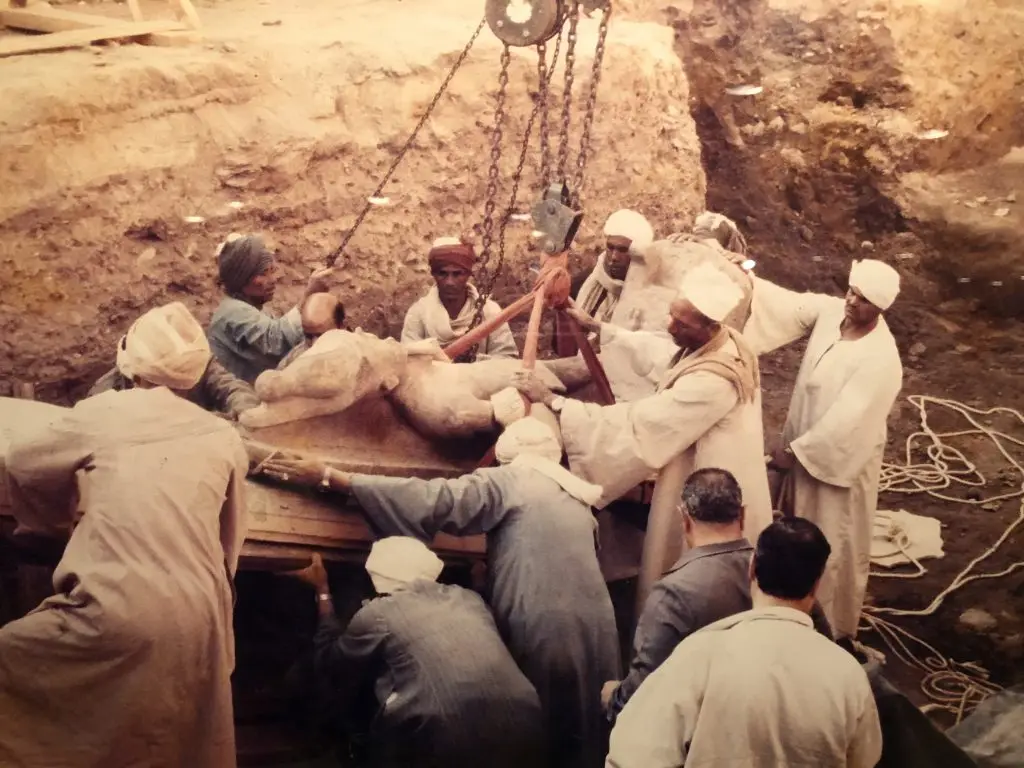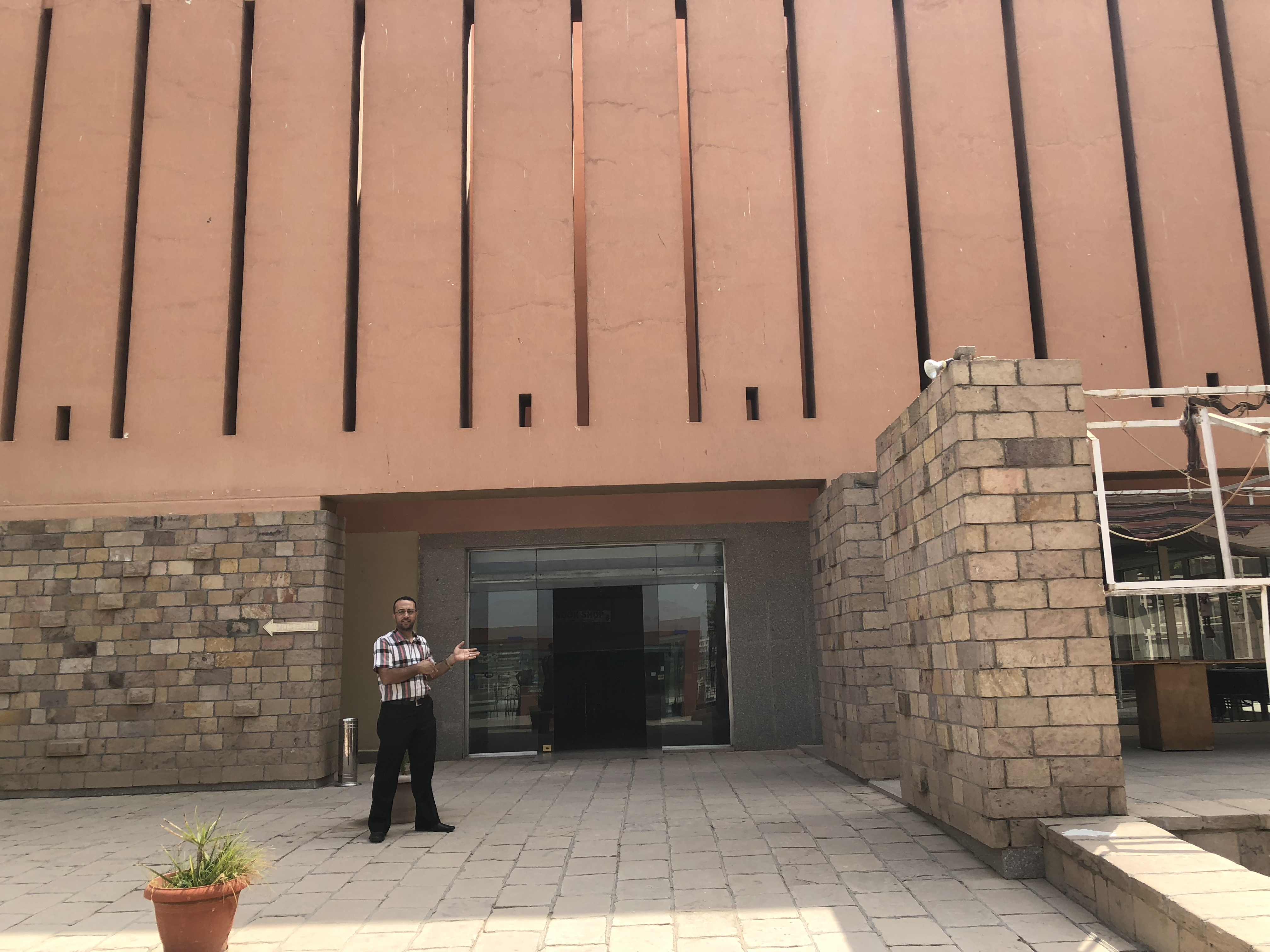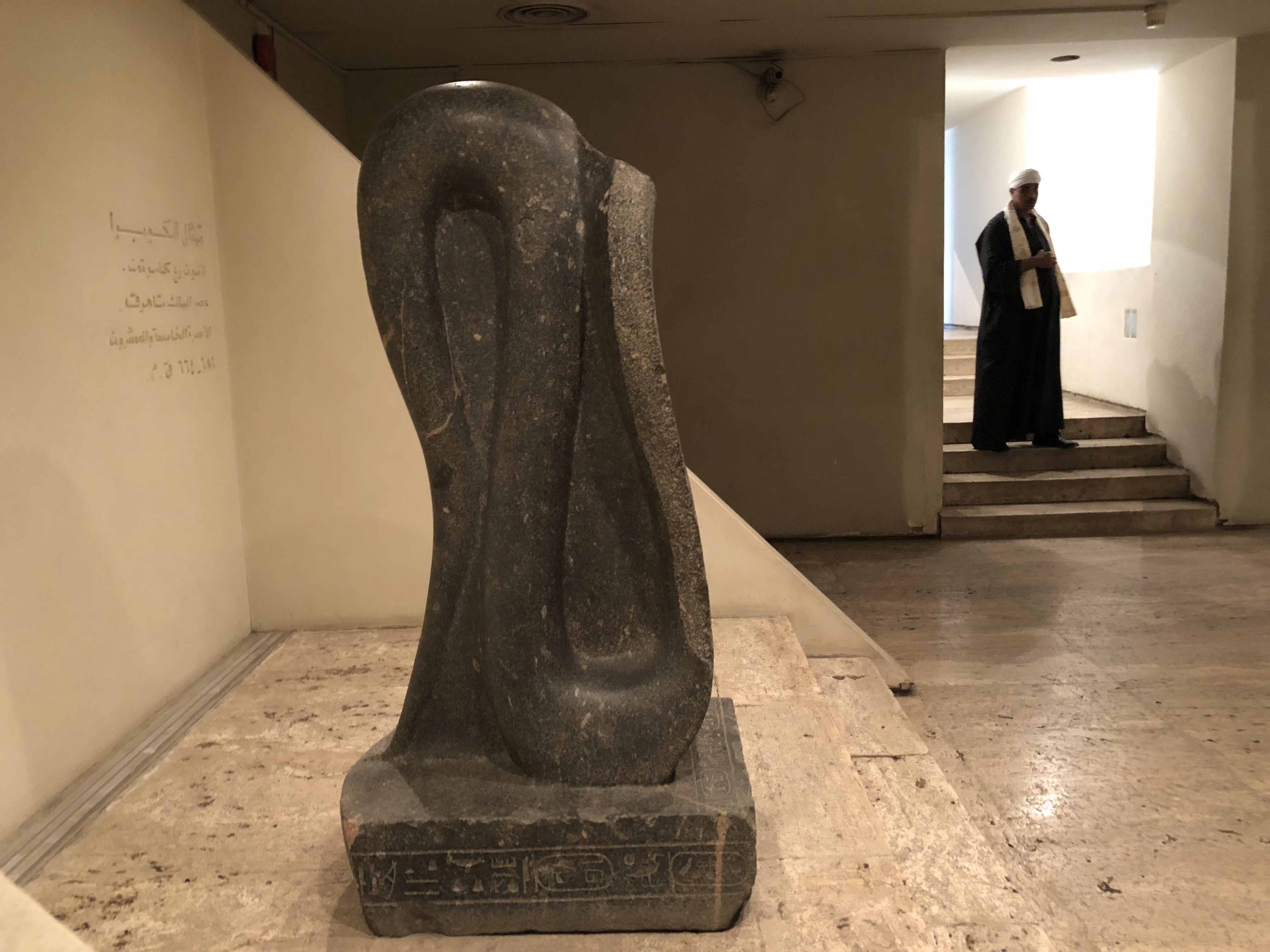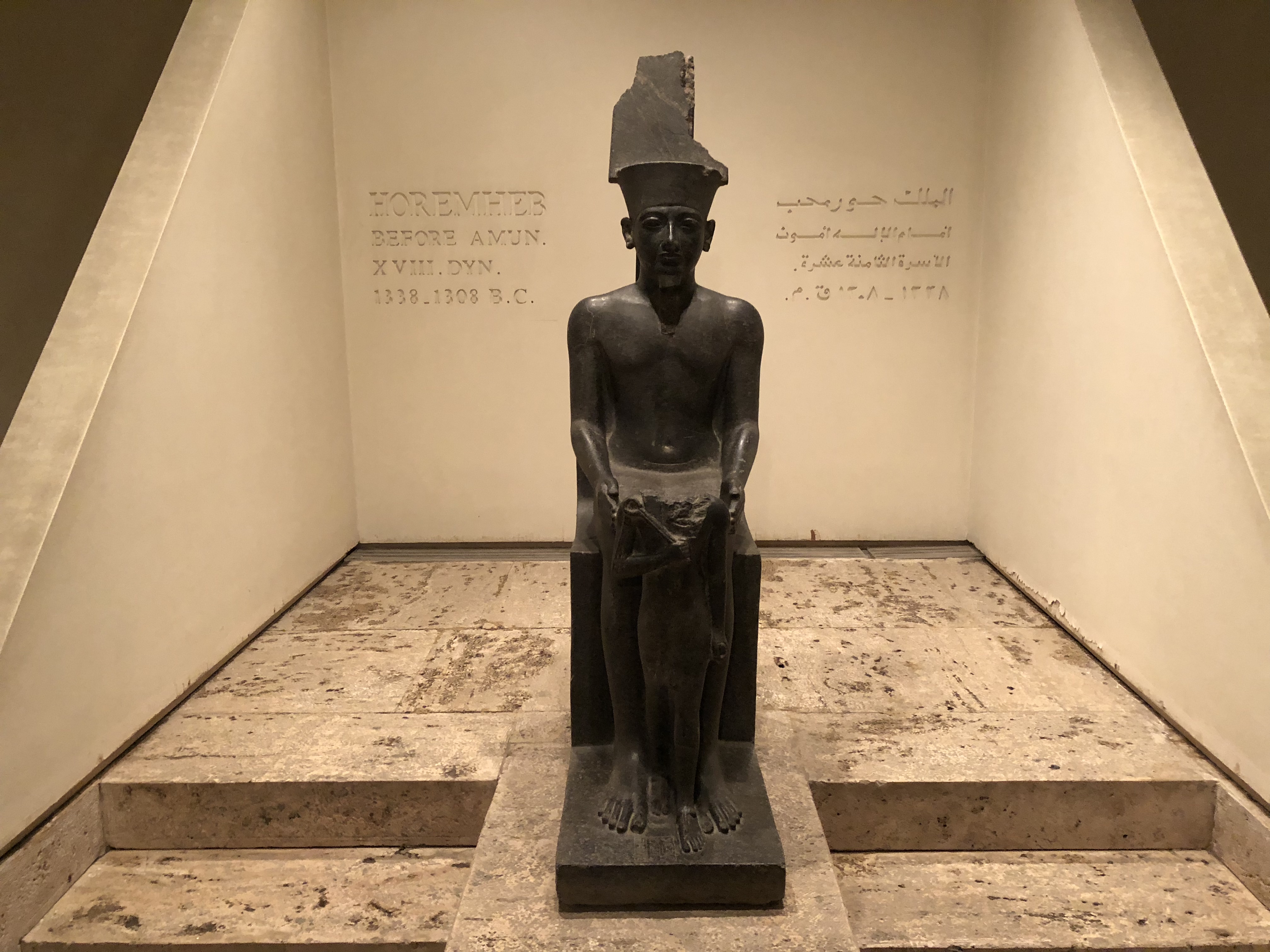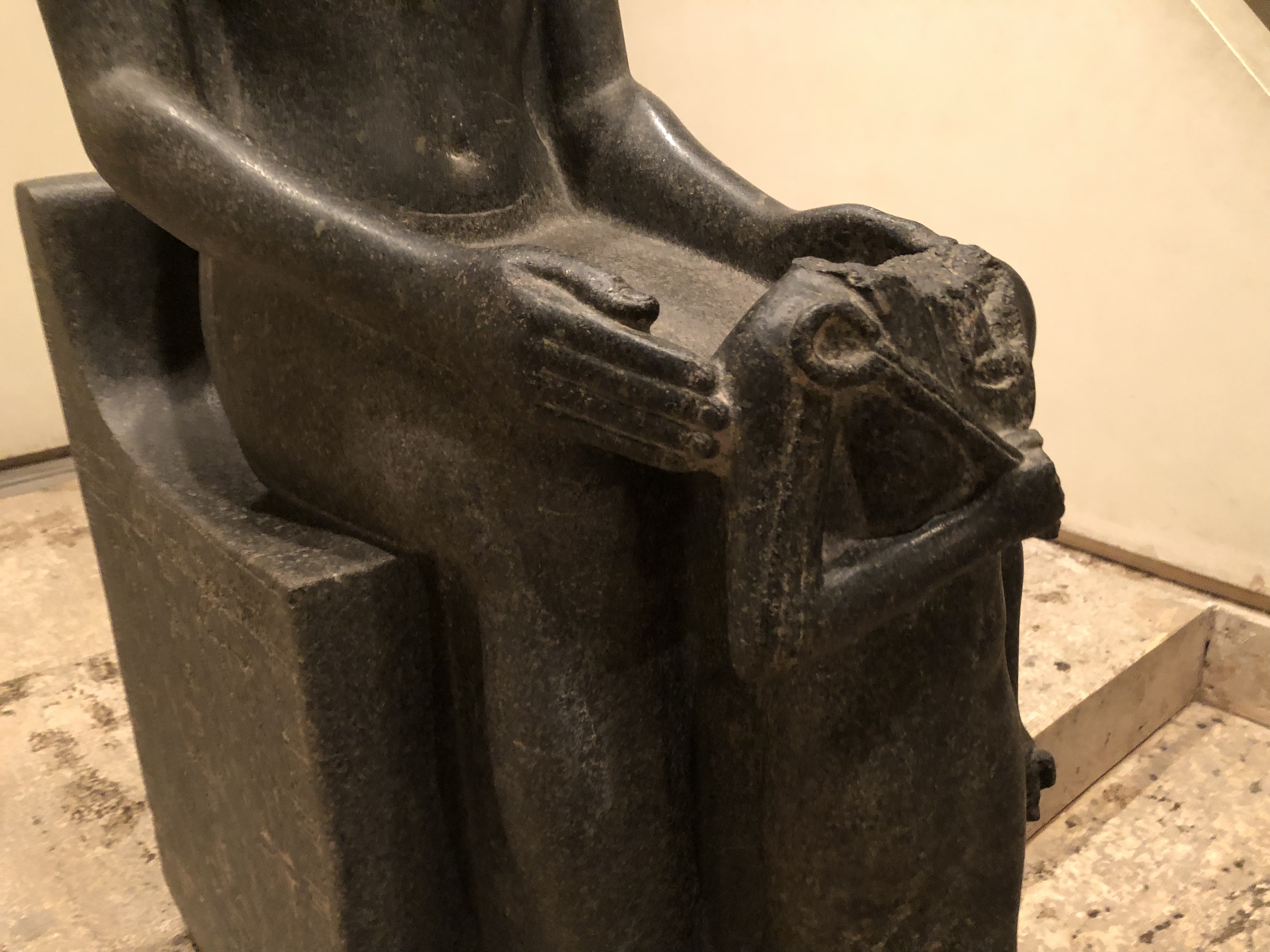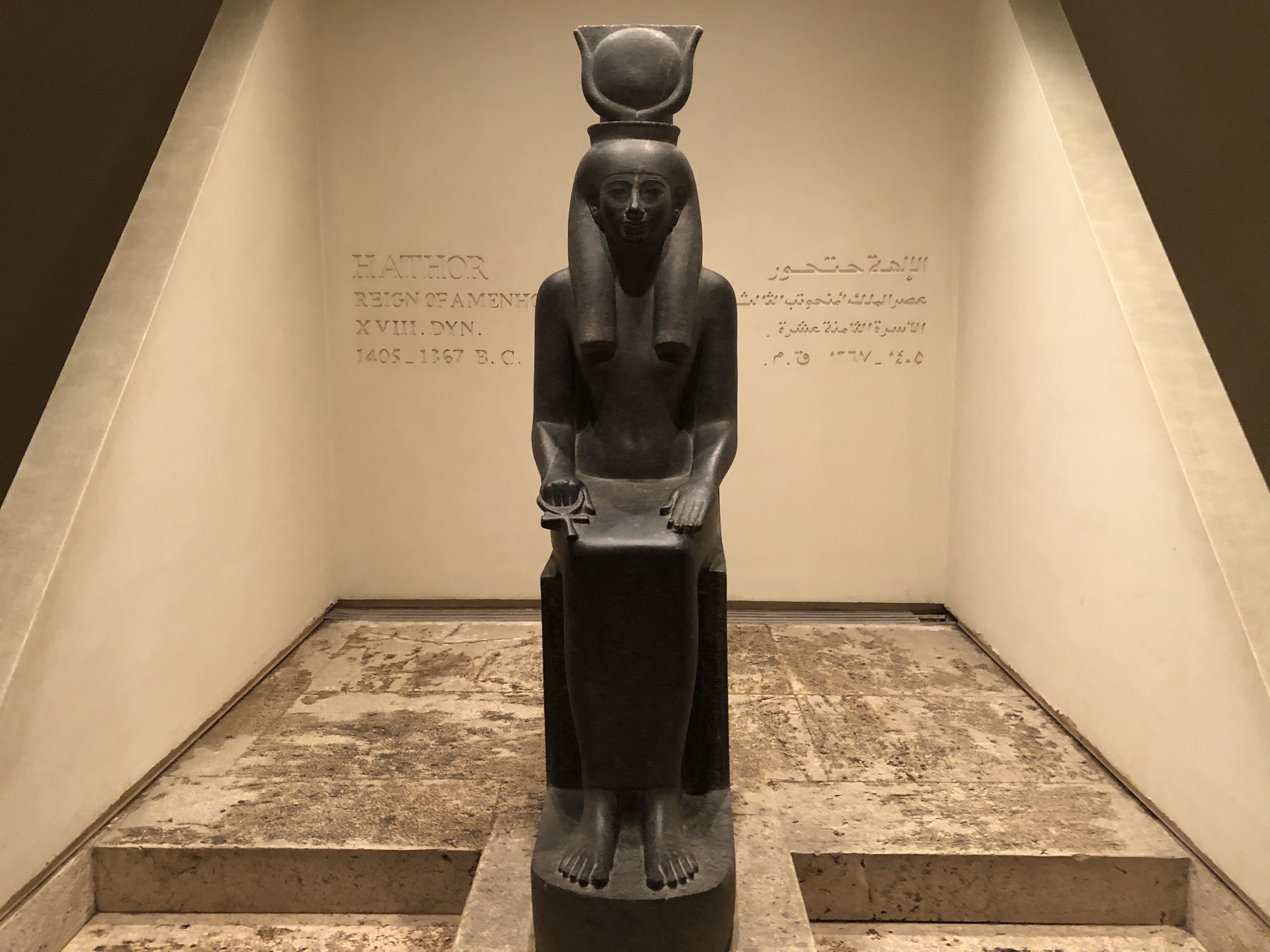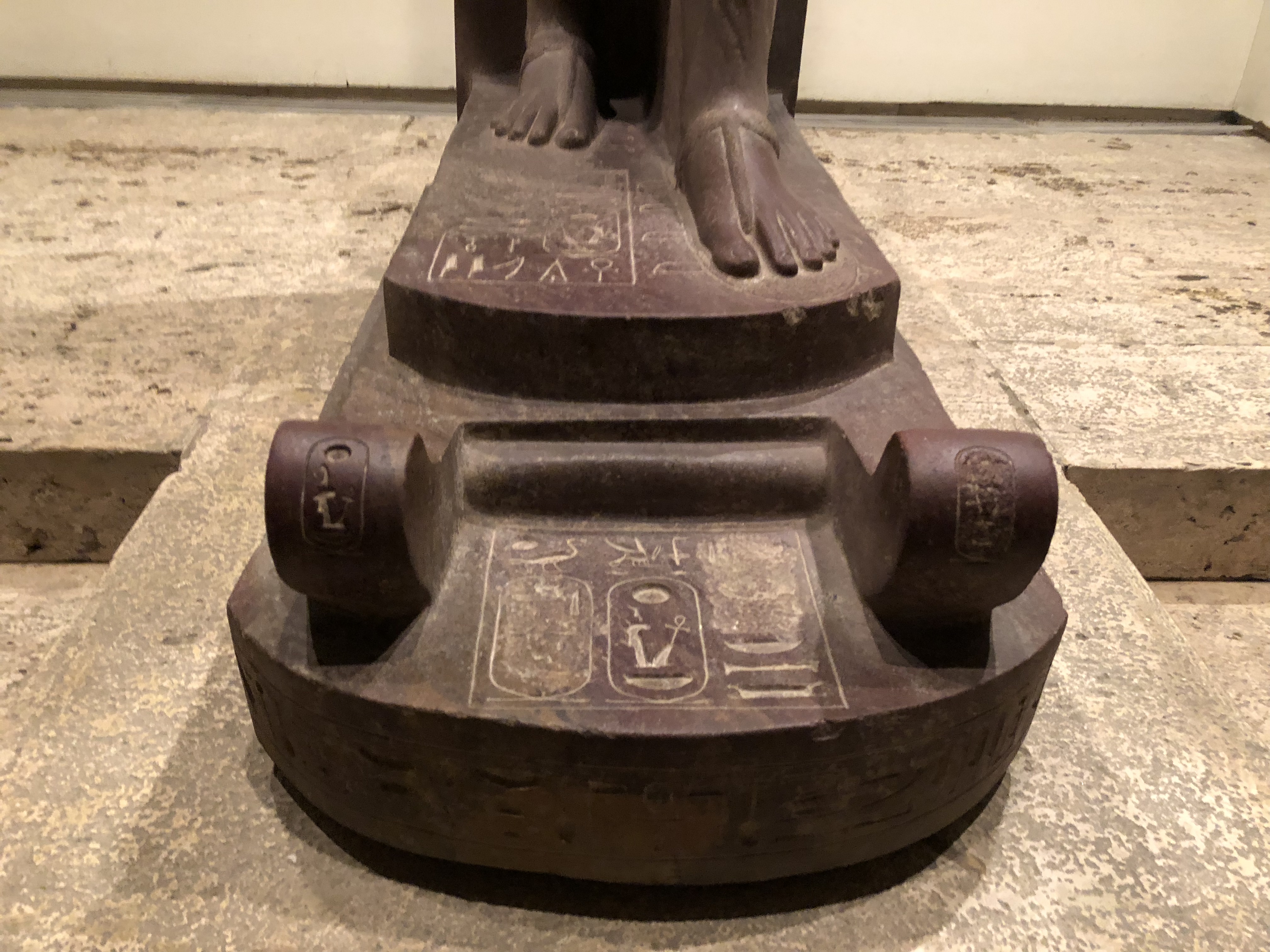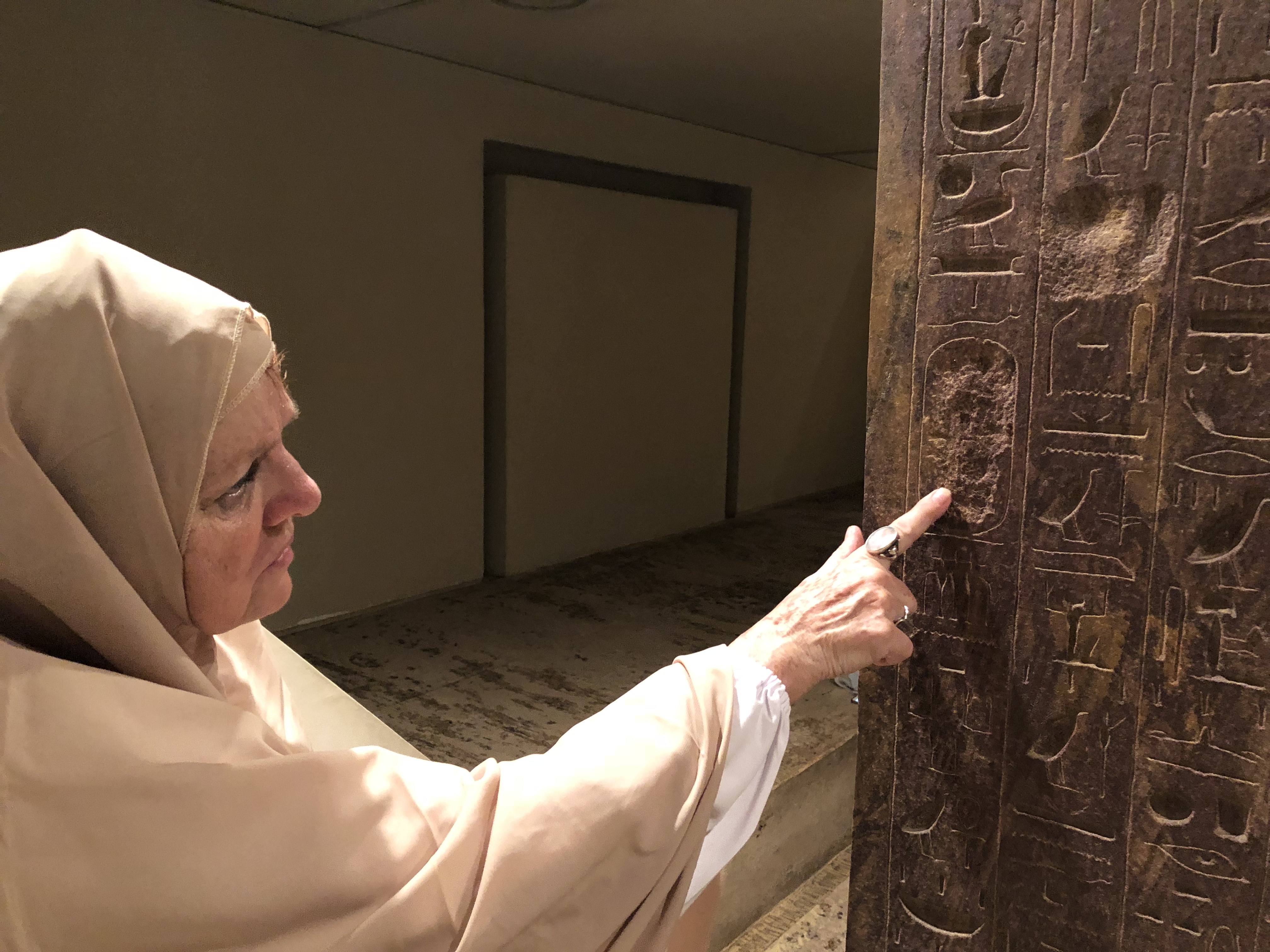BURIED RELICS: A STORY ABOUT THE UNEXPECTED DISCOVERY OF THE LUXOR CACHETTE
On January 22, 1989, a group of Egyptian workers, concerned with the water rising from the ground, engaged in collecting earth samples from the grand open solar court of the 18th dynasty Pharaoh Amenhotep III, at the Luxor Temple, when they came upon a finely polished stone.
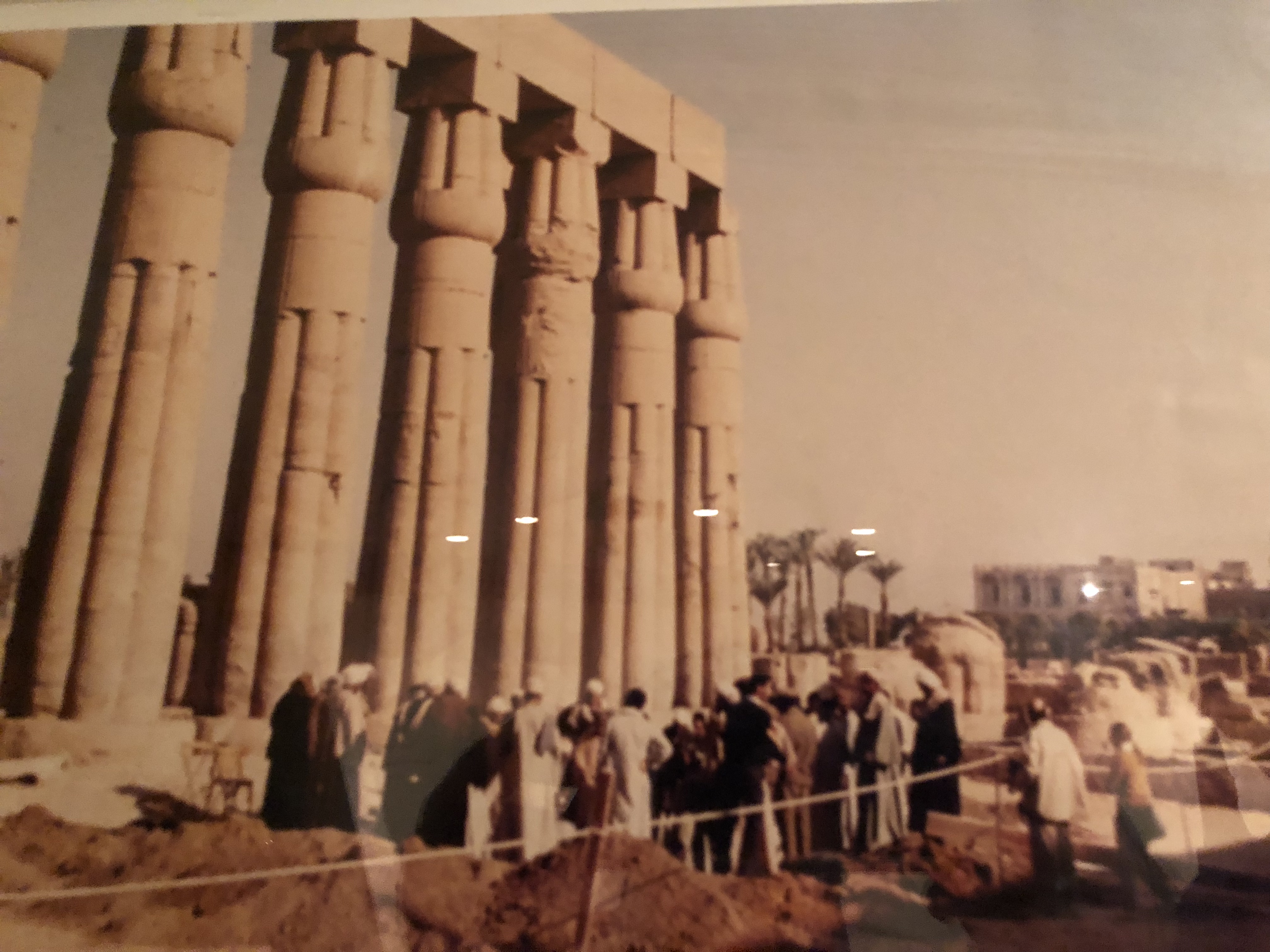
Within the first two hours of the clearing process, the team discovered two holes, thought to be originally prepared for two statues of different sizes. Where did these statues go?
What could be buried beneath the polished stone?
It was reasonable to conjecture that relics of a high order would be buried below.
Afterall, was it not in what is now modern day Turkey, under the feet of the statue of Hermes, just below the surface where a 1st century thamaturist and mystic by the name of Apollonius (Balinus in Arabic) recovered the legendary Emerald Tablet along with books on the knowledge and causes of all things in the depths of the catacomb of Hermes?
Discovering treasures of this magnitude have led to deepening our understanding for the metaphysical make up of man and the greater mysteries of the universe. Could relics buried inside the occult anatmoy of R.A. Schwaller de Lubicz’s “Temple of Man” reveal hermetic messages that if properly understood, may not only awaken the intellence of our hearts but also provide us with the potential to accelerate the evolution of our own humanity?
On the next day the team returns to the site with the intention of removing the polished slab.
To their amazement, first appears a face followed by the emergence of shoulders from a pit.
Before them was an almost life-sized-statue in well preserved condition.
 Further clearance revealed inscription bearing the name of Amenhotep III on the base. The statue was found laying on its right side facing the West. (It’s interesting to note that even the Egyptologists acknowledge that the West is attributed to the resting place of the deceased. From a shamanic perspective we can it is associated often with the other world. From the symbolist point of view the west represents completion of transformation or attainment; fitting for the realized king )
Further clearance revealed inscription bearing the name of Amenhotep III on the base. The statue was found laying on its right side facing the West. (It’s interesting to note that even the Egyptologists acknowledge that the West is attributed to the resting place of the deceased. From a shamanic perspective we can it is associated often with the other world. From the symbolist point of view the west represents completion of transformation or attainment; fitting for the realized king )
 Soon after more and more parts of other statues became visible on both sides of the pit. Five statues were found about three feet below a covering layer of small stones.
Soon after more and more parts of other statues became visible on both sides of the pit. Five statues were found about three feet below a covering layer of small stones.
Eventually a total of twenty six spectacular sculptures of Egyptian Gods (the embodiments of cosmic principles) and Kings (the spiritual or solar principle) were uncovered in near perfect condition.
After hiding away in this cachette, nearly lost to the humam record, these remarkable relics rise once again.
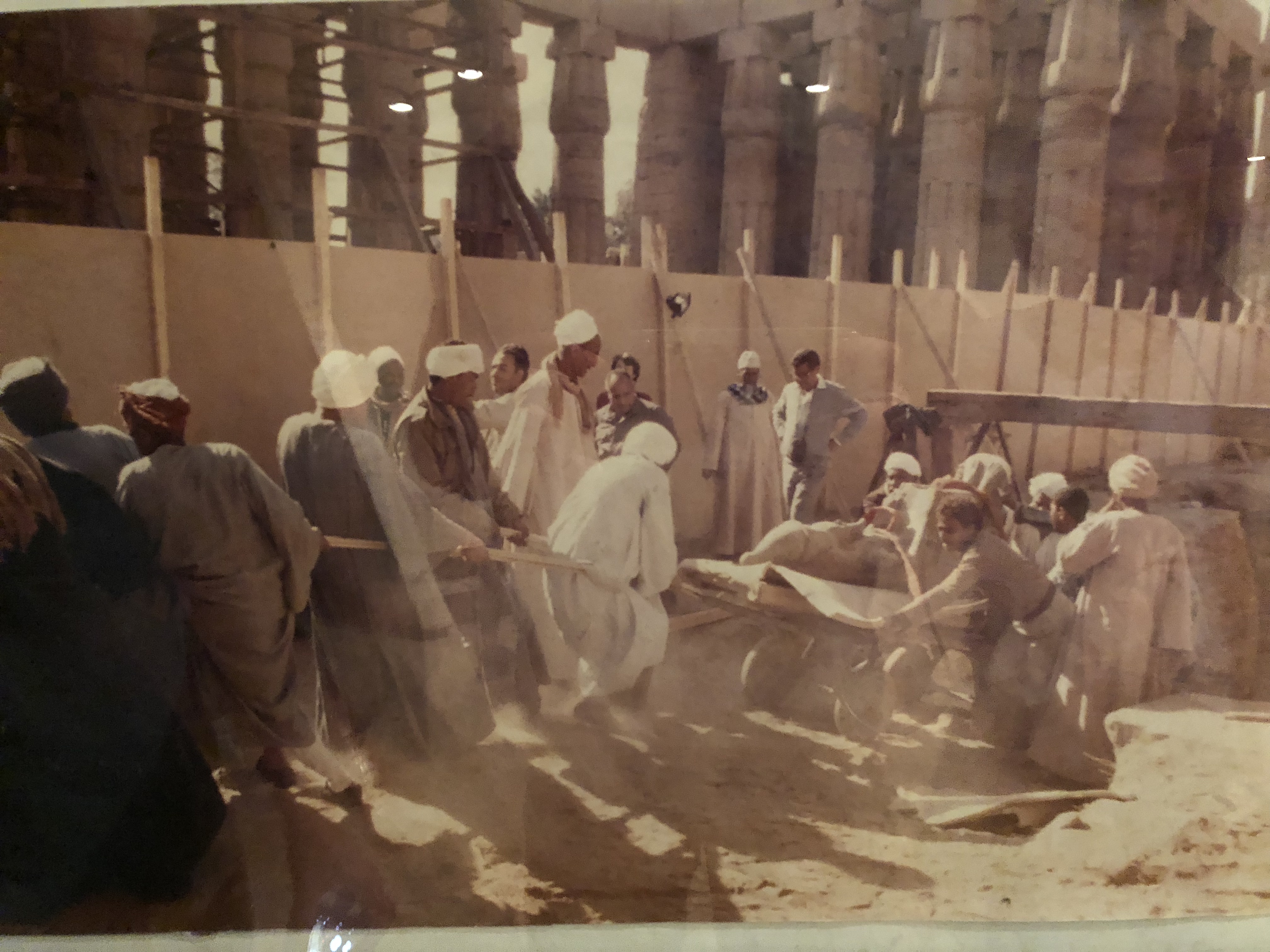 Consider how the great British Egyptologists, such as Sir William Matthew Flinders Petrie and his protege Howard Carter never even knew such precious ancient artifacts were right under their feet the whole time…
Consider how the great British Egyptologists, such as Sir William Matthew Flinders Petrie and his protege Howard Carter never even knew such precious ancient artifacts were right under their feet the whole time…
Under the feet of the great mystic G.I. Gurdjieff who came to Karnak as part his invesgitation into an esoteric tradition…
Under the feet of French Hermeticist, R.A. Schwaller de Lubicz whose study of Luxor was a major breakthrough in our understanding of Ancient Egypt.
The team worked for four months before refilling the pit in April of 1989.
 My retelling of this story pales in comparison to the first-hand account transmitted to me by my dear friend, the great Egyptologist, Dr. Elsayed Hegazy (pictured below overseeing the operation).
My retelling of this story pales in comparison to the first-hand account transmitted to me by my dear friend, the great Egyptologist, Dr. Elsayed Hegazy (pictured below overseeing the operation).
 It was both – an honor and a priviledge to have Dr. Elsayed Hegazy relate his personal experience in connection to this discovery of the Luxor cachette. The Dr. shared his story with such enthusiam, in a way that transported us right back to the scene of the discovery, despite being in his beautiful home in Luxor, Egypt where he hosted my wife and I for several nights.
It was both – an honor and a priviledge to have Dr. Elsayed Hegazy relate his personal experience in connection to this discovery of the Luxor cachette. The Dr. shared his story with such enthusiam, in a way that transported us right back to the scene of the discovery, despite being in his beautiful home in Luxor, Egypt where he hosted my wife and I for several nights.
I spared no minutes digging through his wife’s esoteric library in their home. Among the books I began consuming was her ow rare work on Akhenaten. This was of particular interest to me given the Rosicrucian order, AMORC’s connection to him. She has been a a long time member the order.
 The ancient artifacts extracted from this mission are now on display in the Luxor Museum in Egypt. You can find them in the ‘exhibition hall’ section specifically set up for the Luxor cachette.
The ancient artifacts extracted from this mission are now on display in the Luxor Museum in Egypt. You can find them in the ‘exhibition hall’ section specifically set up for the Luxor cachette.
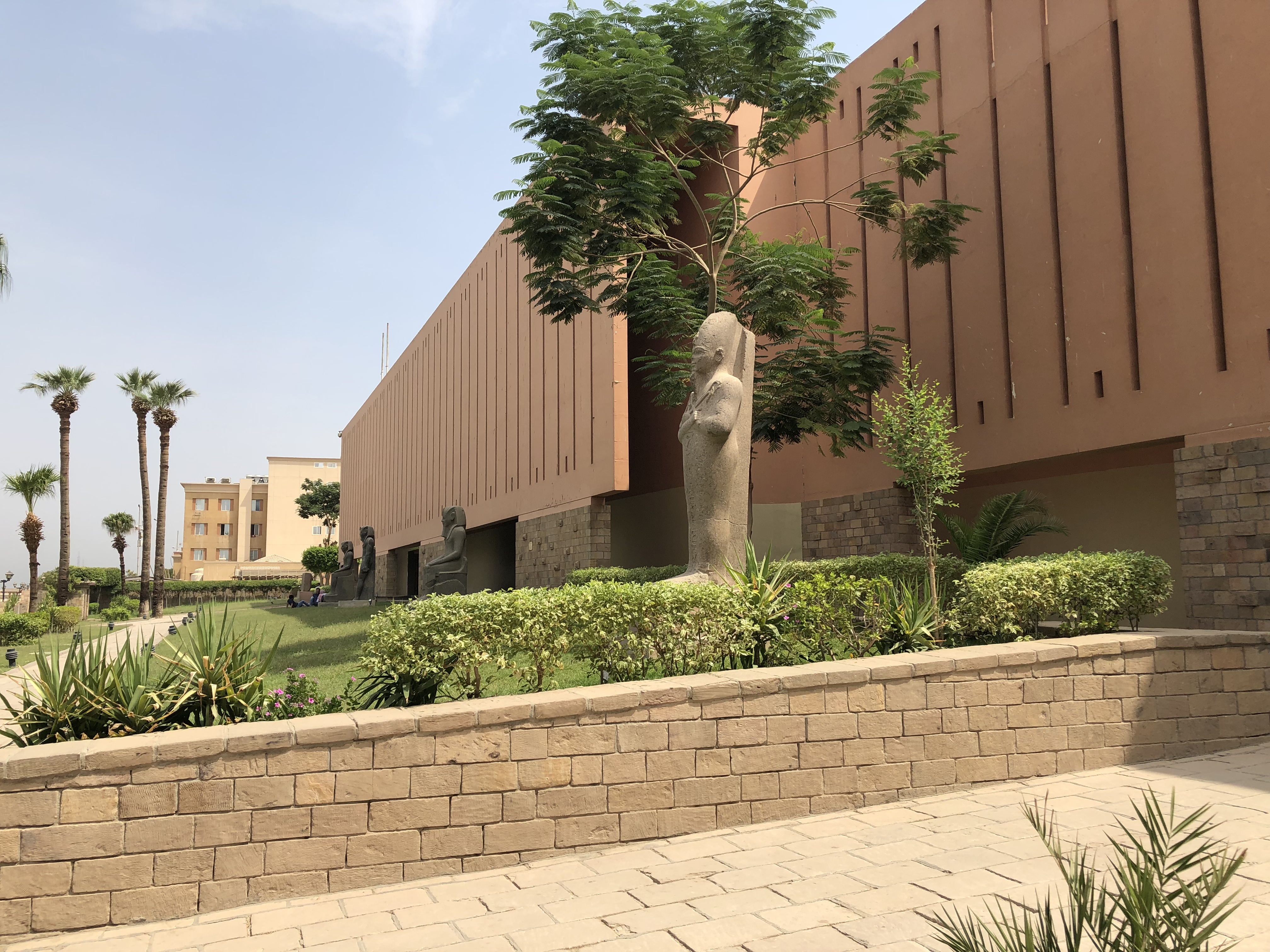 LUXOR MUSEUM
LUXOR MUSEUM
Overlooking the west bank of the River Nile, the Luxor museum, an archeological museum featuring not only the Luxor cachette, but also a collection of impressive restoration projects and other distinguished artifacts you won’t find anywhere else is Egypt often gets overlooked in favor of the Museum of Antiquities in Cairo.
Unlike the Museum of Antiquities in Cairo, The Luxor Museum’s is focussed on presenting only quality pieces in an uncluttered way that is on par with most European museums. Tourists traveling through the Luxor museum will find the multilingual labeling ideal. The restricted but no less valid range of artifacts are equally astonishing as they are unique.
Let us now head inside and take a virtual tour of the Luxor Museum to review some of our favorite featured items.
Luxor Cachette
Upon entering the museum, turn to your immeditate right and just beyond the hall extending from the entrance, you will find the Luxor cachette on display in a dedicated section. You will find a plethora of rather refreshing pieces here including a few items that are always fun for discussion during our Esoteric Egypt symbolist tours.
 Horemheb before the God Atum, 18th Dynasty
Horemheb before the God Atum, 18th Dynasty
Sema Tawy and Symbolism
The union of Upper and Lower Egypt is depicted by knotted papyrus and reed plants. The binding motif represents both harmony through linkage and domination through containment. The duality is an important part of royal iconography. Sometimes the duality is further extended by having the knotted plants extend and bind foreign foes (both from the North and the South) as well.
A symbolist set of eyes will find the law of three depicted here as well as the esoteric principles of balanced opposites and reconciliation.
Below we see the perspective of Horemheb looking up at the God Atum
Atum looks down upon Horemheb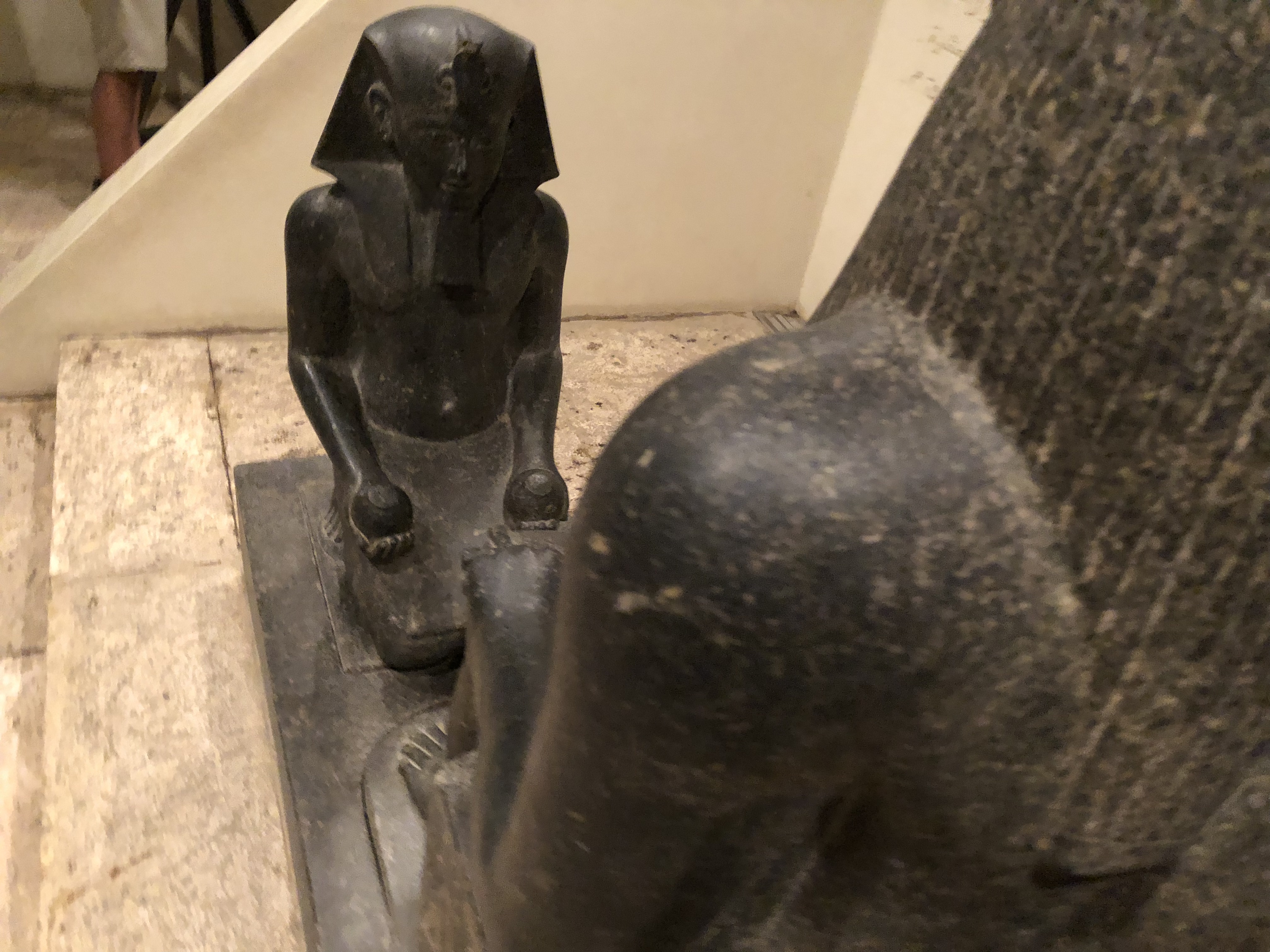 Cobra Statue: Amun Re Ka Mutef
Cobra Statue: Amun Re Ka Mutef
This is the only instance of this cobra statue that I’ve come across in all of my travels throughout Egypt. Below is the side profile.
Horemheb Before Amun
Hathor
Amenhotep III

Here we have Amenhotep III, the crown jewel initating the discovery. Imagine Dr. El Sayed Hegazy and his team as they first notice the head and shoulders of this almost-human-sized statue lying in the pit, buried below the surface of the Luxor Temple.
Notice his left foot forward, in action, initiating movement.
Cartouch is defaced. Guess who?
Dr. El Sayed Hegazy’s wife, our dear friend, Khadija Hammond reads the glyphs and points out more damage to the cartouche on the rear of Amenhotep III’s statue.
Mut and Amun
According to Normandi Ellis and Nicki Scully, authors of The Union of Isis and Thoth: Magic and Initiator Practices in Ancient Egypt, the name Mut in the ancient Kemetic language means both “death and “mother.”
The vulture headdress that most often signifies Mut is worn by queens and is relates to the function of queens to procreate and nature their children.
The vulture indicates motherhood because in desert climates, where starvation is a possibility, the self-sacrificing vulture was observed to pick at its own breast and feed its flesh to its children.
 Notice here how it is Mut who has her hand around her consort Amun as if she is presenting him. She is putting him forward.
Notice here how it is Mut who has her hand around her consort Amun as if she is presenting him. She is putting him forward.
This is a powerful example of matriarchy in ancient Egypt. It was the divine feminine who was the head of the family.
There is much more to see in this section that was specifcally carved out for the cachette of Luxor. To experinece the rest of this room through the eyes of a symbolist, I encourage you to join us for the Esoteric Egypt symbolist tour.
For now, let us move on to the main floor of the Luxor Museum where we find the granite head of King Amenhotep III, a New Kingdom relic from Qura.
MAIN FLOOR OF THE LUXOR MUSEUM
Khadija and Karina sit in front of the statue of King Thutmosis III, directly across from the giant head of King Amenhotep III giving us scale.
This enormous Amenhotep III head statue is believed to be one of a series of colossal statues that once decorated the funerary temple of the King in western Thebes.
Here’s a close up of the Greywacke stone statue of King Thutmosis III, taken from Karnak Temple, one of the finest statues ever carved in Ancient Egypt.
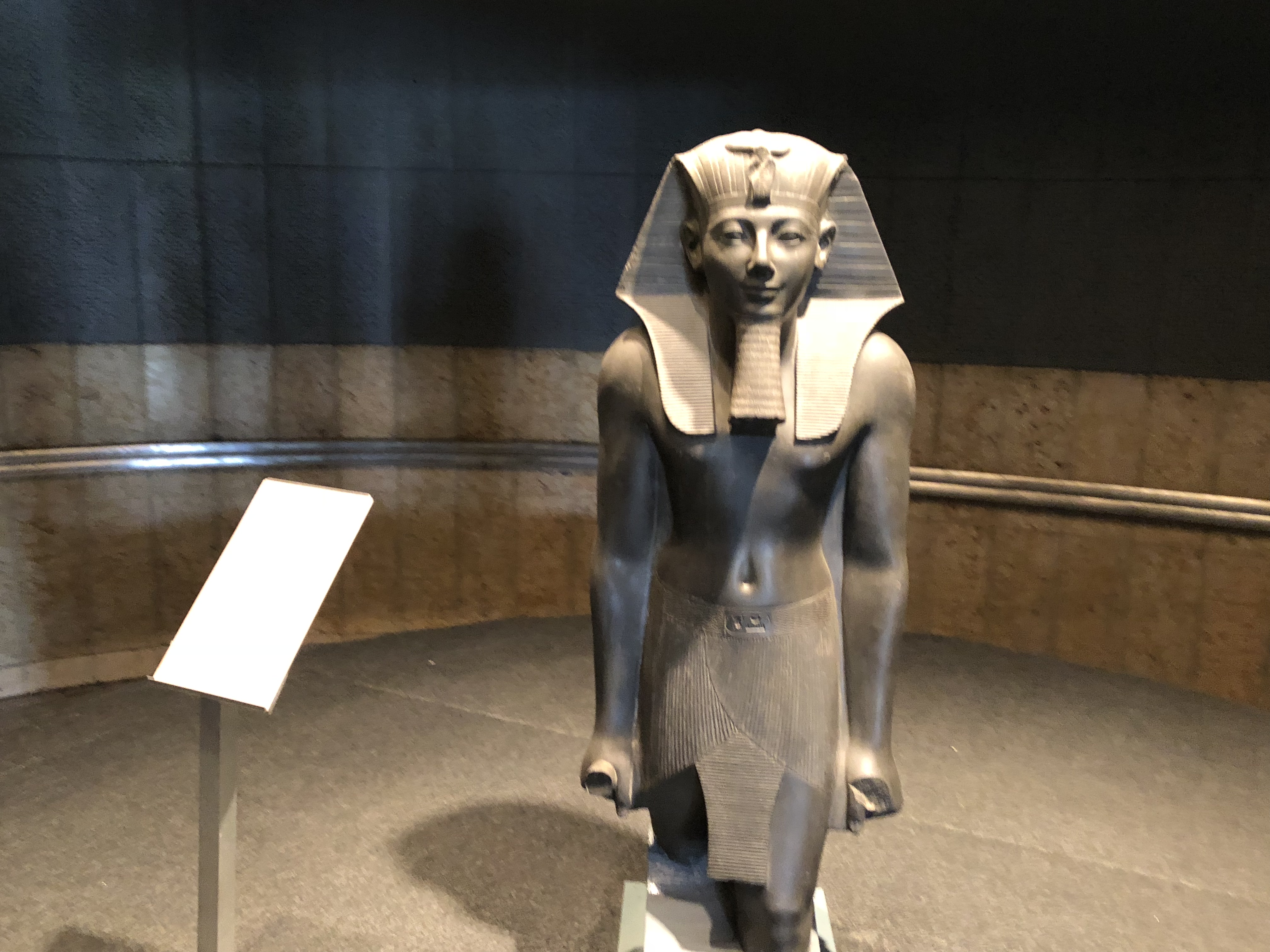 Thutmosis III appears eternally youthful and confident of his divine majesty and power. He is shown wearing the nemes headdress with the protective uraeus, false beard and an ornate kilt with a buckle inscribed with his cartouche.
Thutmosis III appears eternally youthful and confident of his divine majesty and power. He is shown wearing the nemes headdress with the protective uraeus, false beard and an ornate kilt with a buckle inscribed with his cartouche.
This could very well be one of the world’s first name plate belt buckles!
Thuthmosis III was a remarkable ruler who not only changed the course of history but also had a change of heart later in his career when he had a spiritual reformation. To this day his mystery school affiliation is largely ignored by modern Egyptologists. However, it is known in esoteric circles that Thutmose III, directed the mystery school of Karnak and organized the mystery schools together as a single Order. The Rosicrucians maintain that these ancient mystery schools teachings are the foundation of the Rosicrucian Order, AMORC. You can click here to learn more about The Sacred History of the Rosicrucians.
HEAD OF SESOSTRIS III (KHAKAURE SENUSRET)
Sesostris III, Middle Kingdom 1878-1840 BC
The placard at the museum identifies Kahkaure Senusret by his hellenized name, Sesostris III. He was known for extending Egypt’s borders into Nubia, where he established, Kumma or Semna East, an archaeological site in modern day Sudan. He also cut the cataract at Elephantine Island, likely during one his famed Nubia campaigns.
 The granite statue taken from Karnak finds King Sesostris III wearing a double crown with the protective Uraeus on his forehead and a false bread attached.
The granite statue taken from Karnak finds King Sesostris III wearing a double crown with the protective Uraeus on his forehead and a false bread attached.
The head of Sesostris III captures a major break through in Middle Kingdom Egyptian art. Artisans capture the humanity of this great ruler and his facial features. The older style is idealized without blemish where as this shift in art produces a more individualized style.
My mentor, John Anthony West would often demonstrate his sense of humor, joking about how Sesostris III doesn’t appear to enjoy his role as pharaoh. Perhaps Sesotris III didn’t like the job.
Sobek with Amenhotep III
This piece is unique in that the calcite (Egyptian Alabaster) used is a stone other pharoahs do not rountinely employ.
 The double statue of the crocodile neter, Sobek, and the youthful 18th Dynasty pharaoh, Amenhotep III (Neb-Maat-Ra) was found in the Sobek temple at Dahamsha during 1967 by a team of workers digging out the Armant Canal in a shaft closed by sandstone slab. The shaft slid into place on two Bronze wheels.
The double statue of the crocodile neter, Sobek, and the youthful 18th Dynasty pharaoh, Amenhotep III (Neb-Maat-Ra) was found in the Sobek temple at Dahamsha during 1967 by a team of workers digging out the Armant Canal in a shaft closed by sandstone slab. The shaft slid into place on two Bronze wheels.
 Sobek, the cosmic principle of death or “westing” in ancient Egyptian terms, is seated in human form and holds the Ankh giving life to Amenhotep III who wears the Nemes headdress, with the uraeus and royal beard.
Sobek, the cosmic principle of death or “westing” in ancient Egyptian terms, is seated in human form and holds the Ankh giving life to Amenhotep III who wears the Nemes headdress, with the uraeus and royal beard.
Thutmosis III
Look close and you can see the gold used for Pharaoh Thutmosis III, who ruled Egypt from 1500 to 1447 B.C., and organized the first esoteric school of initiates founded upon principles and methods similar to those perpetuated today by the Rosicrucian Order, AMORC.
 Relief of Chariot Worshop
Relief of Chariot Worshop
This limestone relief fragment from a decorated tomb in Saqqara is set within a group of royal workshops.
 The chariot wheels are made of many layer sof leather treated in a precise way.
The chariot wheels are made of many layer sof leather treated in a precise way.
My mentor, the rogue Egyptologist, John Anthony West envisioned modern day chariot racing in Egypt being a draw for tourists, but was never given the opportunity to share this idea with Zahi Hawass.
Block Statues
No traces of block statues are found in the Old Kingdom, it’s mostly a New Kingdom practice where we find the head raised above the level of the block. John Anthony West felt a PHD study on the block statues could be rewarding. This is one of his many potential PHD studies for aspring Egyptologists.
In some cases the figure is more visible then others. The usual explanation for this from the Egyptologists is related to economic purpose to save money. However, the esoteric explanation is that SET imprisons spirit in matter and so the figure is shown emerging from the imprisonment of matter.
 In this instance we have, Yamunedjeh, an important messenger and architect. He was also an initiate of the the first esoteric mystery school of Ancient Egypt founded upon principles and methods similar to those perpetuated today by the Rosicrucian Order, AMORC.
In this instance we have, Yamunedjeh, an important messenger and architect. He was also an initiate of the the first esoteric mystery school of Ancient Egypt founded upon principles and methods similar to those perpetuated today by the Rosicrucian Order, AMORC.
At age 33, Yamunedjeh crossed the Euphrates behind Pharaoh Thutmose III, who ruled Egypt from 1500 to 1447 B.C, in order to secure the boundaries of Egypt.
The block or cube symbolically implies the imprisonment of man placed in material existence, the temporal world. It is the principle of SET who imprisons spirit in matter.
Notice Yamunedjeh’s head and hands just above the cube. Egyptologists explain this as a economic device to save money however, my mentor, John Anthony West informed me of his theory that it may reflect the initiates level of attainment. Given all we know about the didactic art produced by the mystery schools, I think it’s reasonable to conjecture.
Battle Axes
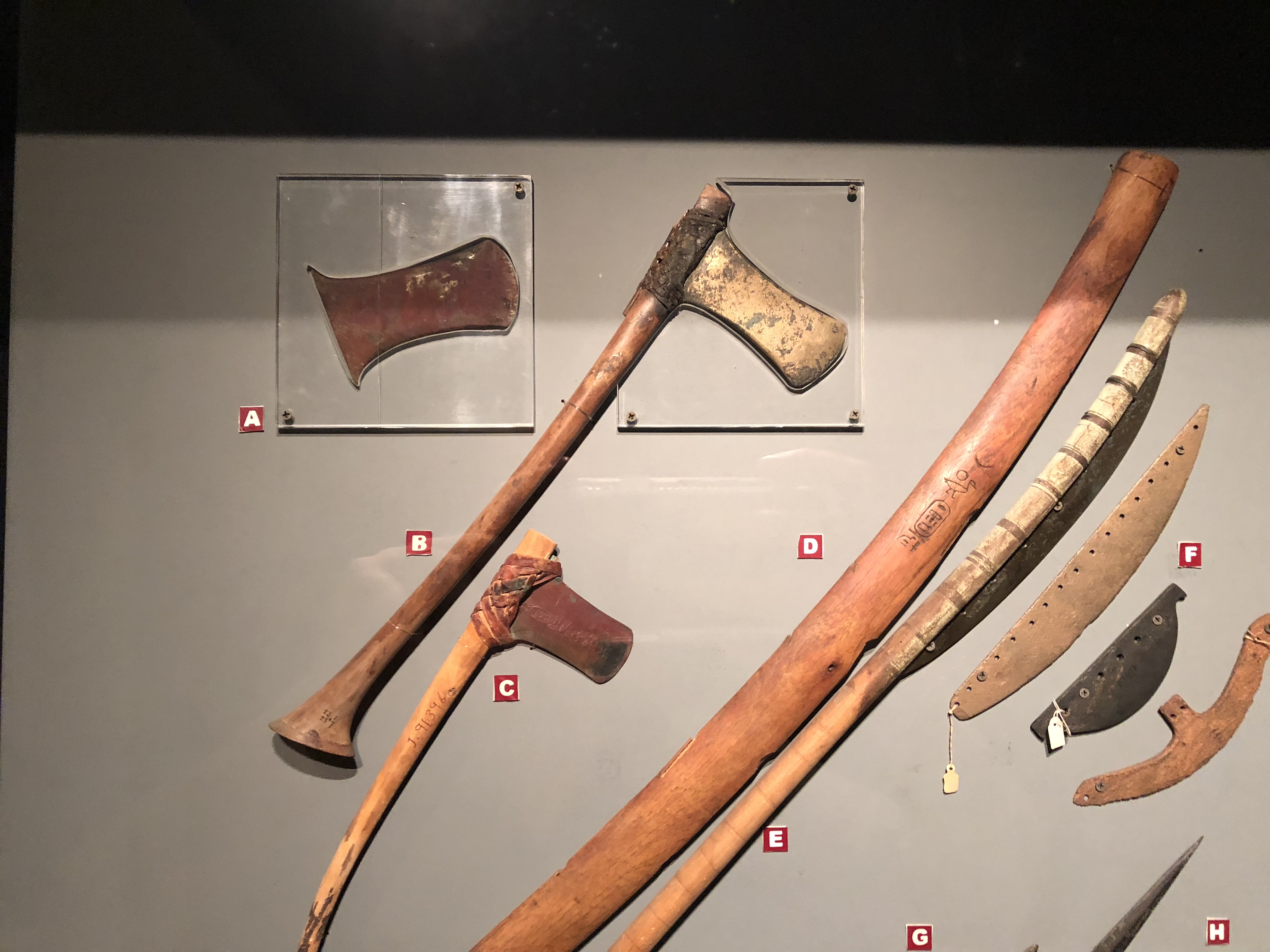 I’ts undecided in Egyptology what the heiroglph for “neter” actually depicts. Some argue that it may be a flag as we know flags were used on the temples of ancient Egypt. On the other hand its commonly accepted that the neter glyph is an axe.
I’ts undecided in Egyptology what the heiroglph for “neter” actually depicts. Some argue that it may be a flag as we know flags were used on the temples of ancient Egypt. On the other hand its commonly accepted that the neter glyph is an axe.
Wrestlers
Modern wreslers can identify with the holds depicted here that are still employed in the world of wrestling.
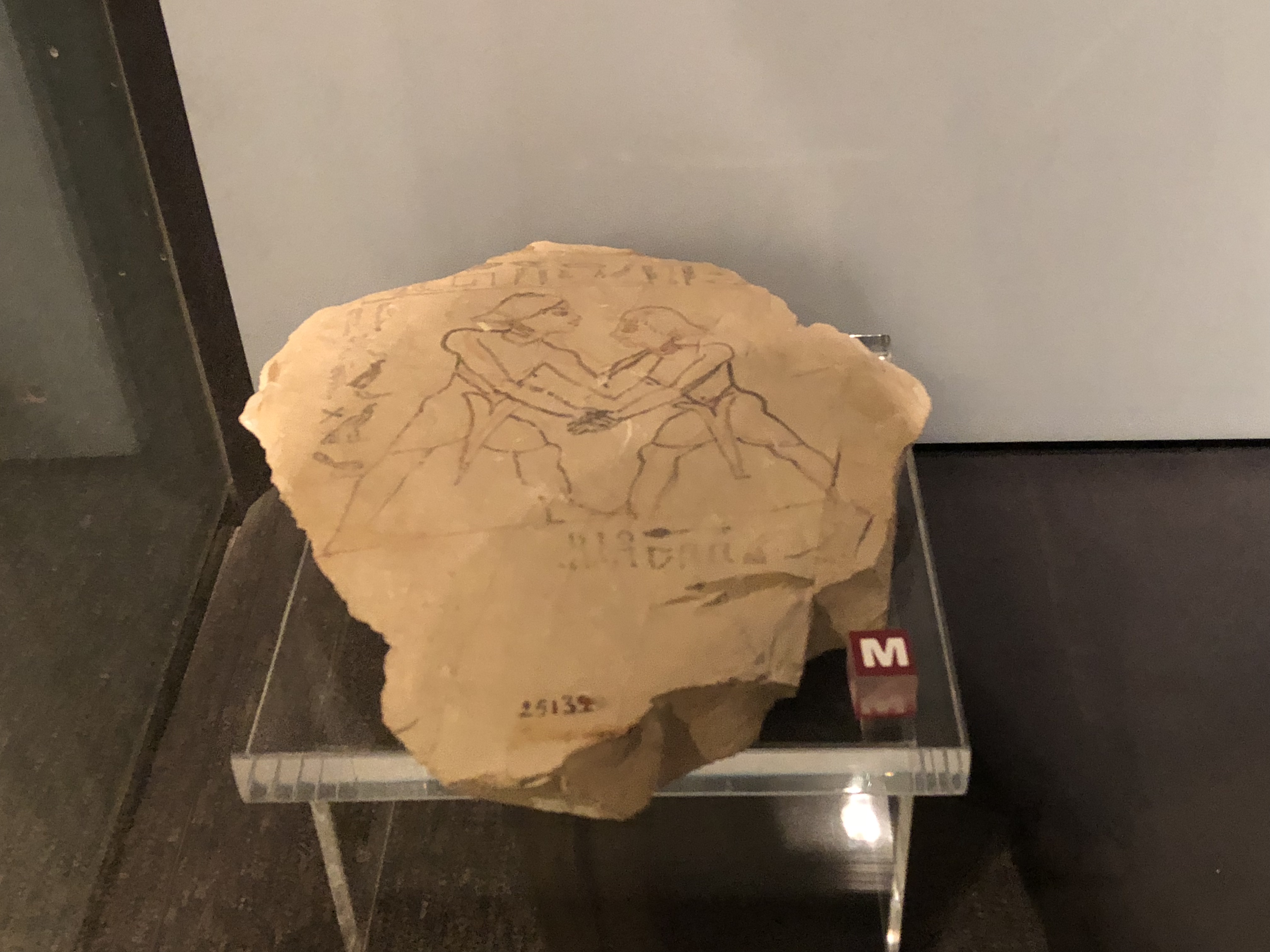 Satue of Nebre
Satue of Nebre
This peculiar statue sets its self apart with very unique looking features from the style of dress to the staff of office, the lioness headed Sekhmet, the female aspect of the fire principle and neter of war.
 However, it sereves him well as Nebre was a commander under Ramesses II who was in charge of Zawiet um el-Rakhem, a fortress erected to protect the western border of Egypt from the Libyans. This 19th dynasty statue was discovered there.
However, it sereves him well as Nebre was a commander under Ramesses II who was in charge of Zawiet um el-Rakhem, a fortress erected to protect the western border of Egypt from the Libyans. This 19th dynasty statue was discovered there.
Captured Enemy
Another unique piece this time representing a captured enemy. Captured enemies are common recurring theme yet we don’t find any statues anywhere else in Egypt that look like this one.
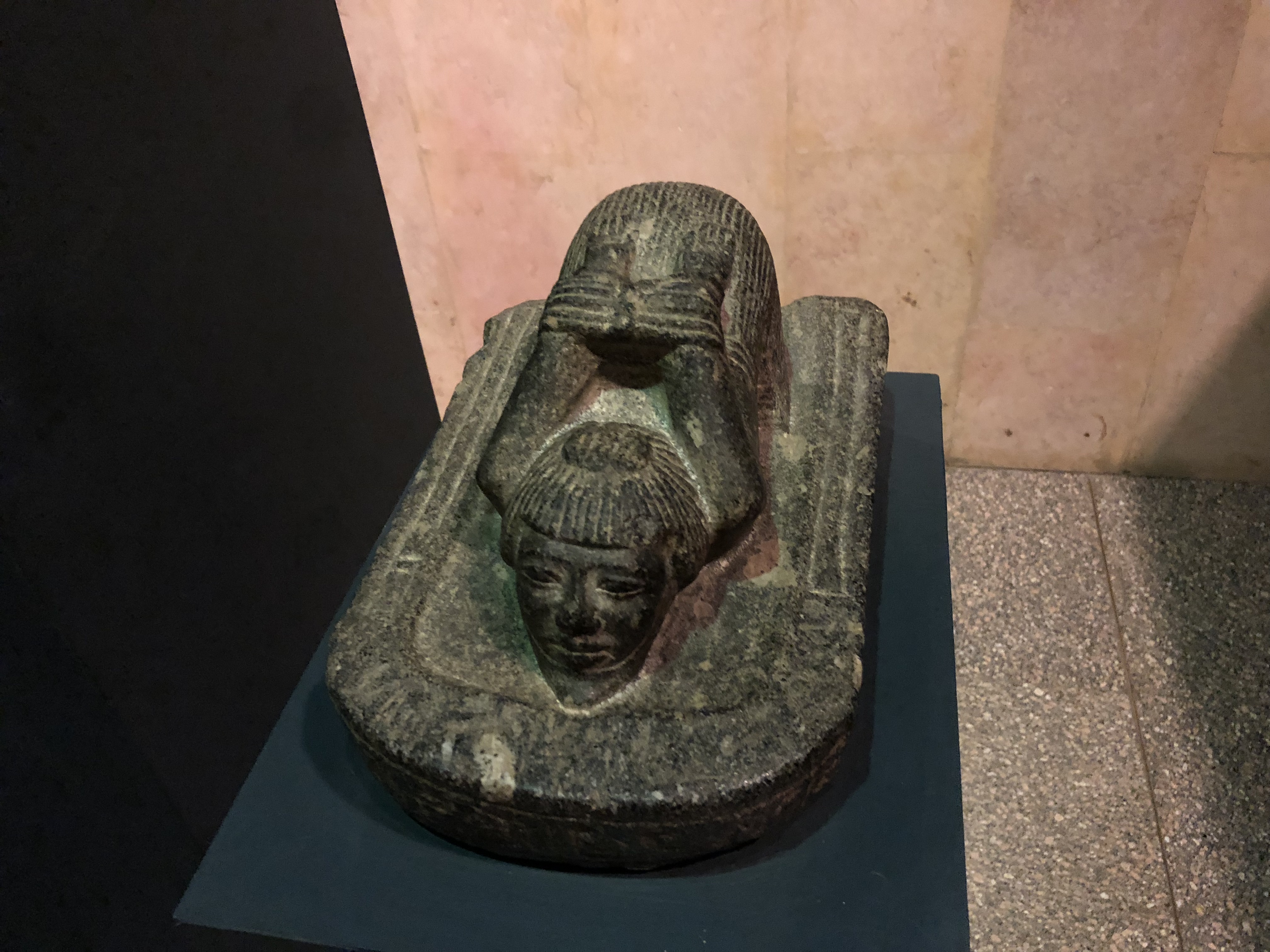 Colossal Sekhmet Head
Colossal Sekhmet Head
Here Karina is depicted alongside the Colossal Sekhmet head for scale. This head wouldve been attached to a statue likely to be about 20 ft high.
 A pecularity here is that when we see Sekhmet wears an oval shaped solar disc. She is often depicted wearing a circular solar disc. The circular vs. oval shape solar discs is one of those potential PHD studies that John Anthony West would often point out.
A pecularity here is that when we see Sekhmet wears an oval shaped solar disc. She is often depicted wearing a circular solar disc. The circular vs. oval shape solar discs is one of those potential PHD studies that John Anthony West would often point out.
Scribe
Notice the look of contemplation in his face. Amenhotep, Son of Hapu was to Amenhotep III what Imhotep was to Djoser at Saqqara.
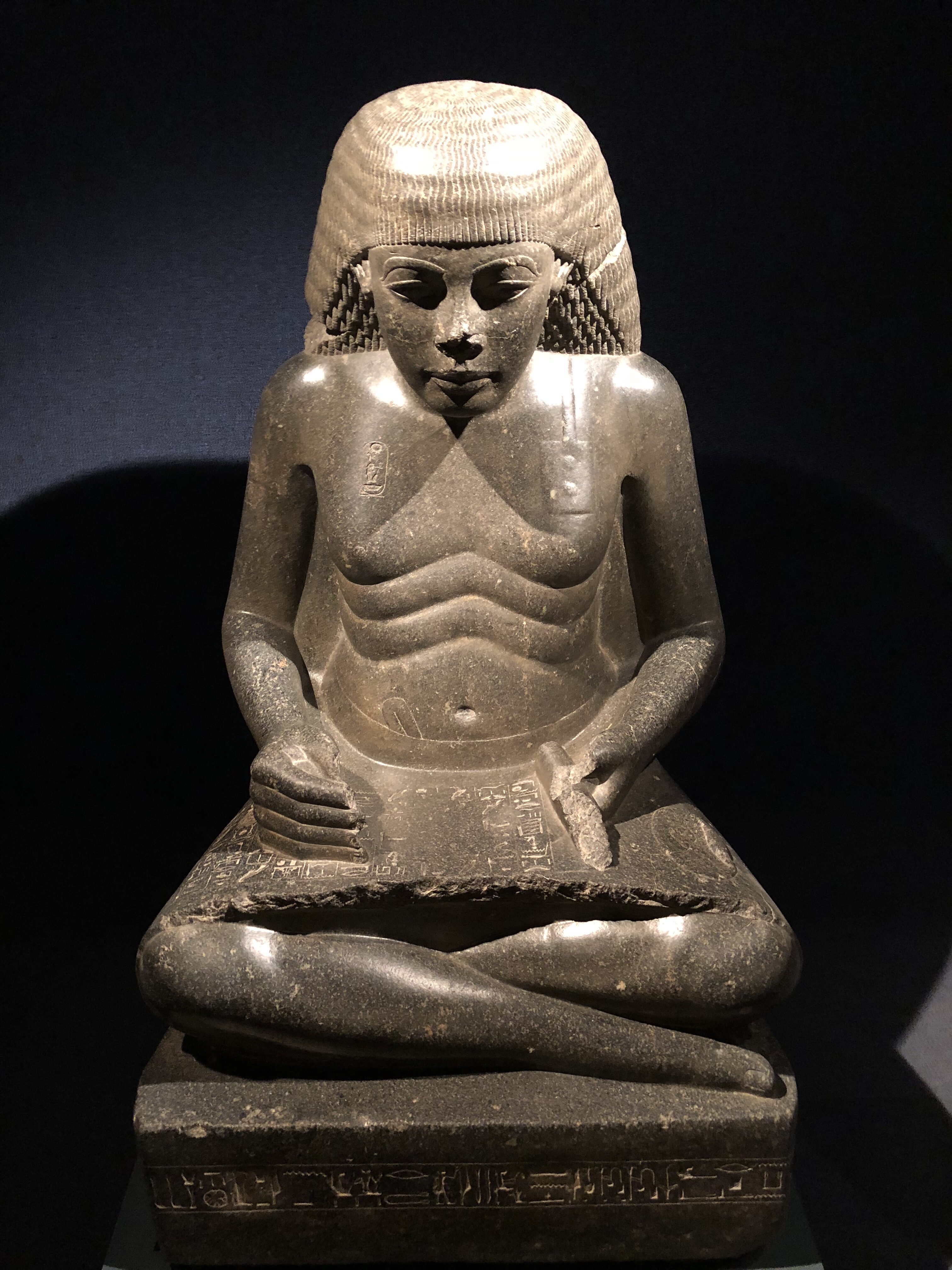
Masonic Origins in Ancient Egypt
The traditional masonic doctrine is believed to have derived from Ancient Egypt in stages, not necessarily by direct transmission.
Here we find a number of tools and symbols that will resonate with the traveling man who knows his way around the block.



Hatshepsut: The Divine Feminine in Rare Form
Here is A RARE image of HATSHEPSUT depicted as a WOMAN. She is often dressed as a man when appropriating the role of Pharaoh. She NEVER concealed her feminine identity, but she had herself depicted as a pharaoh, dressing like a man and even wearing the false beard.
 It is important to note that Hatshepsut was not the first Queen of Egypt to reign as Pharaoh, nor would she be the last, but she was undoubtedly the most prominent. Queen Nitiqret of the 6th dynasty is an example of an early dynastic Queen who also reigned as Pharaoh. The last Queen to to have pharaonic titles was Tausert, wife of Seti II in 19th dynasty. There are other examples. However, Hatshepsut’s achievements and the duration of reign distinguish her from the rest.
It is important to note that Hatshepsut was not the first Queen of Egypt to reign as Pharaoh, nor would she be the last, but she was undoubtedly the most prominent. Queen Nitiqret of the 6th dynasty is an example of an early dynastic Queen who also reigned as Pharaoh. The last Queen to to have pharaonic titles was Tausert, wife of Seti II in 19th dynasty. There are other examples. However, Hatshepsut’s achievements and the duration of reign distinguish her from the rest.
At her birth she was given the name Hatshepsut, meaning “Foremost of the Noble Ladies”.
In this RARE image of Hatshepsut we see her depicted as the Queen. Thutmose II (her Royal consort) leads the way. She is not yet assuming the role of Pharaoh in this depiction. It was not until the passing of her royal husband, Thutmose II that she takes on the role of Pharaoh, a role in her era, traditionally reserved for men.
 Akhenaten: Heretic or Hero?
Akhenaten: Heretic or Hero?
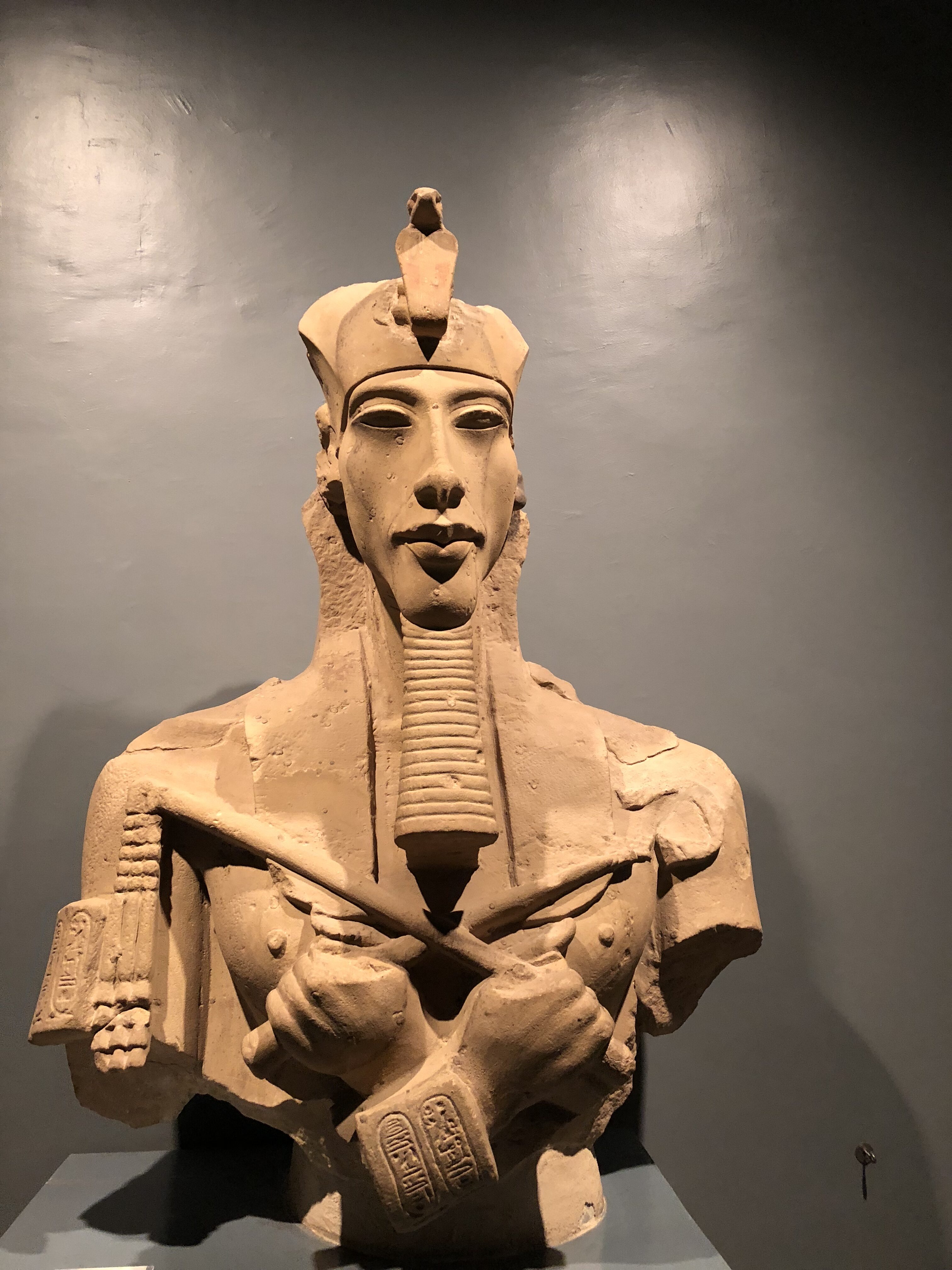

Beyond the plethora of pictures I’ve posted here, there is yet much more imagery for one to see and experience within Egypt’s Luxor museum. Nutrious artifacts for the not only our cerebral intelligence but our intelligence of the heart.
Craving for more unique antiquities of interest from this often overlooked and uncluttered storehouse of relics, but not yet in position to travel to Egypt? No worries, I have you covered because I added over 100 + images not included in this blog article of the numerous and numinous items on display in the Luxor museum. Tale a look for yourself in the photo album on my Facebook page by Clicking here.
Now Seeking Initiates: Come along and experience the Luxor museum first-hand as part of the Ancient Egypt Mystery School’s community adventure. Imagine placing yourself in the presence of the vital force transmitted by through these ancient relics that not only speaks not only to our cerebreal intelligence but also fuses with the intellgence of our heart. Join me on tour in Egypt for Esoteric Egypt – A Symbolist Tour with Anyextee.
